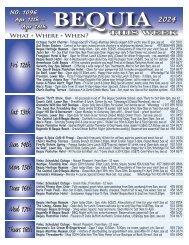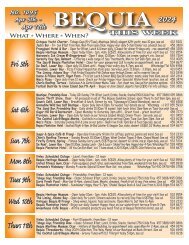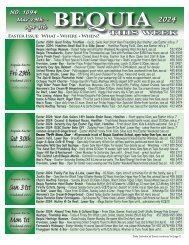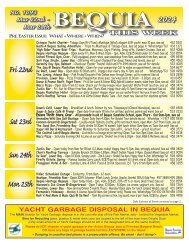Caribbean Compass Yachting Magazine - May/June 2022
Welcome to Caribbean Compass, the most widely-read boating publication in the Caribbean! THE MOST NEWS YOU CAN USE - feature articles on cruising destinations, regattas, environment, events...
Welcome to Caribbean Compass, the most widely-read boating publication in the Caribbean! THE MOST NEWS YOU CAN USE - feature articles on cruising destinations, regattas, environment, events...
You also want an ePaper? Increase the reach of your titles
YUMPU automatically turns print PDFs into web optimized ePapers that Google loves.
MAY/JUNE <strong>2022</strong> CARIBBEAN COMPASS PAGE 24<br />
BOOK REVIEW BY JOHN EVERTON<br />
A Book for All Tastes<br />
A Sea Dog’s Tale: The True Story of a Small Dog on a Big Ocean, by Peter<br />
Muilenburg. ©2012, published by Cadent Publishing and distributed by the University<br />
Press of New England. 272 pages. ISBN 978-1-937644-07-9 (paperback), ISBN 978-1-<br />
937644-08-6 (ebook).<br />
I first met the author in 1962, when I was 14 years old, at Brent School in the<br />
Philippines. I wrote about my 50-year friendship with Peter in <strong>Caribbean</strong> <strong>Compass</strong><br />
in the January 2020 issue (see page 41 at www.caribbeancompass.com/online/<br />
january20compass_online.pdf). Sadly he passed away after battling Parkinson’s<br />
disease for more than 30 years — an ordeal through which he never once showed a<br />
glimmer of self-pity. He lived life to the hilt, never wasting a moment, and by the end<br />
when he was ready to meet his maker he certainly had no regrets.<br />
Re-reading A Sea Dog’s Tale with a new perspective after many years convinced me<br />
that Peter’s stories could be appreciated by the general public, not just boat and dog<br />
lovers and people who have known him. In other words, a book for all tastes. This<br />
can be attributed to Peter’s skill as a writer: the ability to paint a portrait and put<br />
the reader in the middle of it. His use of words results in stories that flow seamlessly<br />
and hold the reader’s attention from the first sentence.<br />
The sea dog in the title is Santos, an all black purebred schipperke (meaning little<br />
captain in Flemish). He is an ideal boat dog, being small with a feisty spirit, the perfect<br />
burglar and man-overboard alarm with his incessant barking at anything that moves<br />
in the water. Schipperkes were originally bred to be shipmates on Belgian canal barges.<br />
The book, with chapters arranged in chronological order, starts with the<br />
Muilenburgs’ acquisition of the puppy from a boat he and his wife met on the Indian<br />
River in Florida. At the time, Breath, their 42-foot gaff ketch, was on her maiden<br />
voyage. Succeeding chapters trace Santos’s travels through Florida, the Bahamas,<br />
on through Hispaniola and Puerto Rico, and to the Muilenburgs’ homeport in St.<br />
John, USVI.<br />
Santos’s experiences continue with voyages to Venezuela, across the Atlantic to<br />
Spain and the Med, and cruising 200 miles up the Gambia River in West Africa,<br />
during which his adventures included being lost overboard and held for ransom.<br />
Throughout these stories Peter and his family (loyal wife Dorothy and sons Raffy<br />
and Diego) are portrayed as a team working aboard Breath. Peter’s devotion to<br />
Dorothy and the close bonds he builds with his sons throughout their experiences<br />
and adventures play a huge role in shaping the relationship among them all.<br />
Peter was a keen observer of nature in all its forms: weather, life underwater,<br />
animals and plants and human nature.<br />
Although Peter uses Santos as a motif for the broader experiences of his family on<br />
Breath, Santos emerges as the foremost character. After all, if Santos hadn’t been<br />
there, many of these stories would not have happened. As it is, his presence adds a<br />
special resonance to all the stories.<br />
Peter gives us the impression that he can actually get inside Santos’s mind and see<br />
what makes him tick. His empathy for animals adds flavor to the book. Other<br />
strengths in Peter’s writing are his creative use of similes, rendering apt powers of<br />
description, and his ironic sense of humor, which often involves making himself the<br />
butt of his own jokes.<br />
Peter’s stories are full of emotion, a prime example being “Santos in Corfu,” which<br />
includes a tearful story told to Peter about the Holocaust. As Peter recounts the story,<br />
tears are transmitted from the teller to the author to the reader. Tears were flowing<br />
down my cheeks for the second time in a month; I had re-read it earlier in another<br />
volume of Peter’s entitled Adrift on a Sea of Blue Light, where it was originally published.<br />
It’s been a wonderful time for me re-reading Peter’s books with my morning coffee.<br />
I feel like I’ve been able to share time with the Muilenburgs, each of whom I know<br />
well, albeit at a younger age in a different time. Through his writing, Peter’s spirit<br />
still burns brightly.<br />
Happy reading!<br />
CARIBBEAN FOLKTALES BY TELFOR BEDEAU<br />
THE NIGHT LION RAN<br />
Grenadian folk tales are called Nancy Stories. To begin a story the narrator says,<br />
“Tim Tim!” and the audience answers, “Papa Belcome.” At the end of the story the<br />
narrator either says, “I was there but they gave me one kick and I end up here,” Or<br />
“The story end and the wire bend.”<br />
Some of the most popular Nancy Stories are those about animals personified.<br />
In these stories the males are addressed as Compere (Comrade) and the females<br />
as Macmere.<br />
Narrator: Tim Tim!<br />
Audience: Papa Belcome!<br />
Narrator: Once upon a time, the animals used to gather in a clearing near a stream<br />
in the forest on moonlight nights to cook and enjoy themselves with games, music<br />
and songs. They never invited Compere Lion. It was too dangerous to have him<br />
around. To everybody’s peace of mind, Compere Lion’s home was a very long distance<br />
away. However, that was no good reason to be careless, so they commissioned<br />
Compere Sheeshut (bat) and his men to patrol the area around their playground.<br />
Things went well for a long time. The animals had fun every time the moon was out<br />
at night. However, news travels and Lion heard about the activities taking place in<br />
that part of the forest. He thought it was a good opportunity to get an easy meal, but<br />
he also knew it would not be so easy to approach the gathering in the form of a lion<br />
as the other animals would be sure to have patrols that would warn them in time of<br />
his coming. He therefore decided to settle down and plan how to get between the<br />
animals without frightening them away.<br />
Lion developed a good plan. He got the hide of a bull, and with the help of Macmere<br />
Lion he dressed himself with it and attached a pair of horns. He spent time practicing<br />
to bellow and after many bad tries his wife finally told him he was doing fine. Lion<br />
then left his house clad in his bull’s attire and his wife warned him to be careful as<br />
other lions may spring upon him thinking he was a real bull. He promised his wife<br />
a delicious meal within an hour or two.<br />
As soon as Lion left his house and headed in the direction of the animals’<br />
playground one of Compere Sheeshut’s men, who was monitoring his movements,<br />
flew off at a great speed and brought the news that Lion was coming in the form of<br />
a bull. The senior animals had a hasty meeting and decided upon a plan of action.<br />
When Lion arrived everyone greeted him very cordially although he smelled of both<br />
lion and cattle and his paws were clearly printed on the ground. Everyone inquired<br />
as to where his home was. He said his name was Compere Taureau (bull) from<br />
Denland. No one knew of such a place so they agreed it must be very far indeed.<br />
Lion “Taureau” was given a seat close to the cattle family, which made him believe<br />
he had completely fooled the animals. What he did not know was that he was sitting<br />
right over the nest of Compere Tack Tack (an ant about half an inch long that stings<br />
like fire) and his clan of one thousand members. Then there was Compere Bee with<br />
a regiment of soldiers gathered on a branch over his head. Not aware of these<br />
insignificant insects, Lion settled down and gave half of his attention to the<br />
entertainment and half to planning which animal he would grab when the time was<br />
right. He joined the crowd in clapping and occasionally bellowing when the real bulls<br />
did, but he was a bit off in that venture so he pretended to be hoarse.<br />
“ Lion then left his house clad<br />
in his bull’s attire and his wife<br />
warned him to be careful…”<br />
While Lion was pretending to enjoy the show, Compere Parrot was sitting on a<br />
branch observing his actions. Meanwhile Tack Tack and his men were quietly<br />
climbing up and positioning themselves on the very delicate organs located between<br />
Lion’s hind legs, while Bee and his regiment were aiming at his ears, nostrils and<br />
eyes. At this point the party got to a climax. The music and dancing drew Lion’s<br />
attention in such a way that he forgot everything else. Then Parrot gave the signal,<br />
at which Bee and Tack Tack struck their targets with perfect timing and precision.<br />
It took perhaps one thousandth of a second before Lion’s brain was able to register<br />
the severity of the strike, so that Lion for a short time assumed a posture of being<br />
uncertain as to what he should do. At the end of this brief moment the animals heard<br />
a terrifying roar of pain and Lion, whether as a result of muscle power or the<br />
powerful trail of hot material that ejected out of the exhaust at his rear, rocketed<br />
thirty feet into the air and fell in a sitting position into a huge pot of boiling soup. He<br />
rocketed once more, but this time his trajectory was flatter and he quickly accelerated<br />
to a hundred miles an hour! But it was bad for him because his bull-hide dress had<br />
started to fall off and covered his head so he could not see.<br />
Lion bumped into trees. He fell into the river and almost drowned. Next he<br />
started running in a circle and almost collided with a real bull, who butted him.<br />
The young ones pelted him with every missile including cups of hot soup.<br />
Eventually his bull hide stuck on a stump and he was having a problem to free<br />
himself, but Compere Jackass dealt him a severe kick in his rear and the hide<br />
ripped off and he was able to see once more. He then took off at great speed<br />
towards his home never to return again.<br />
While Lion was running away the music started and everyone sang:<br />
Tirez Lion, tirez,<br />
You doh see how Lion running?<br />
Tirez Lion, tirez,<br />
Compere Tack Tack make you run ’way!<br />
I was there, and joined in the singing, but they gave me one kick and I end up here.<br />
Telfor Bedeau is a folklorist, naturalist and hiking guide in Grenada. He is also the<br />
only person to have circumnavigated Grenada by rowboat both clockwise and<br />
counterclockwise. He is now writing his memoirs.<br />
This article first appeared in the July 2002 issue of <strong>Compass</strong>. See our entire Back<br />
Issue Archive at www.caribbeancompass.com/backissues.html.

















